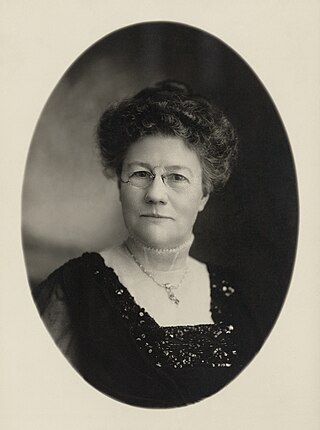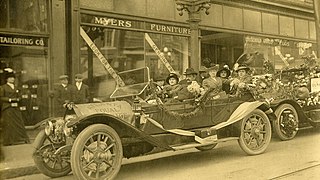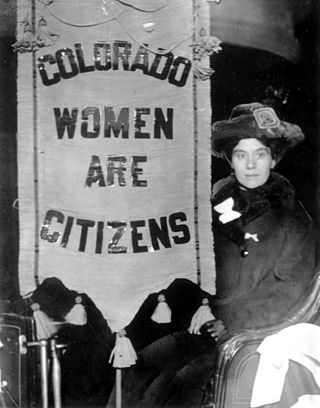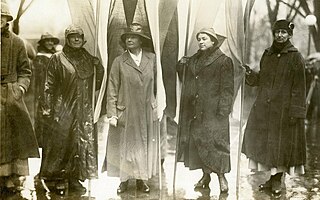
Isabella Beecher Hooker was a leader, lecturer and social activist in the American suffragist movement.
The American Woman Suffrage Association (AWSA) was a single-issue national organization formed in 1869 to work for women's suffrage in the United States. The AWSA lobbied state governments to enact laws granting or expanding women's right to vote in the United States. Lucy Stone, its most prominent leader, began publishing a newspaper in 1870 called the Woman's Journal. It was designed as the voice of the AWSA, and it eventually became a voice of the women's movement as a whole.

Ida Husted Harper was an American author, journalist, columnist, and suffragist, as well as the author of a three-volume biography of suffrage leader Susan B. Anthony at Anthony's request. Harper also co-edited and collaborated with Anthony on volume four (1902) of the six-volume History of Woman Suffrage and completed the project by solo writing volumes five and six (1922) after Anthony's death. In addition, Harper served as secretary of the Indiana chapter of the National Woman Suffrage Association, became a prominent figure in the women's suffrage movement in the U.S., and wrote columns on women's issues for numerous newspapers across the United States. Harper traveled extensively, delivered lectures in support of women's rights, handled press relations for a women's suffrage amendment in California, headed the National American Woman Suffrage Association's national press bureau in New York City and the editorial correspondence department of the Leslie Bureau of Suffrage Education in Washington, D.C., and chaired the press committee of the International Council of Women.

Women's suffrage was established in the United States on a full or partial basis by various towns, counties, states and territories during the latter decades of the 19th century and early part of the 20th century. As women received the right to vote in some places, they began running for public office and gaining positions as school board members, county clerks, state legislators, judges, and, in the case of Jeannette Rankin, as a member of Congress.

Even before women's suffrage efforts took off in Rhode Island, women were fighting for equal male suffrage during the Dorr Rebellion. Women raised money for the Dorrite cause, took political action and kept members of the rebellion in exile informed. An abolitionist, Paulina Wright Davis, chaired and attended women's rights conferences in New England and later, along with Elizabeth Buffum Chace, founded the Rhode Island Women's Suffrage Association (RIWSA) in 1868. This group petitioned the Rhode Island General Assembly for an amendment to the state constitution to provide women's suffrage. For many years, RIWSA was the major group providing women's suffrage action in Rhode Island. In 1887, a women's suffrage amendment to the state constitution came up for a voter referendum. The vote, on April 6, 1887, was decisively against women's suffrage.

This is a timeline of women's suffrage in Rhode Island. Women's suffrage in Rhode Island started with women's rights activities, such as convention planning and publications of women's rights journals. The first women's suffrage group in Rhode Island was founded in 1868. A women's suffrage amendment was decided by referendum on April 6, 1887, but it failed by a large amount. Finally, in 1917, Rhode Island women gained the right to vote in presidential elections. On January 6, 1920, Rhode Island became the twenty-fourth state to ratify the Nineteenth Amendment.

This is a timeline of women's suffrage in Virginia. While there were some very early efforts to support women's suffrage in Virginia, most of the activism for the vote for women occurred early in the 20th century. The Equal Suffrage League of Virginia was formed in 1909 and the Virginia Branch of the Congressional Union for Woman Suffrage was formed in 1915. Over the next years, women held rallies, conventions and many propositions for women's suffrage were introduced in the Virginia General Assembly. Virginia didn't ratify the Nineteenth Amendment until 1952. Native American women could not have a full vote until 1924 and African American women were effectively disenfranchised until the Voting Rights Act passed in 1965.

This is a timeline of women's suffrage in Utah. Women earned the right to vote on February 12, 1870 while Utah was still a territory. The first woman to vote under equal suffrage laws was Seraph Young on February 14, 1870. During this time, suffragists in Utah continued to work with women in other states to promote women's suffrage. Women continued to vote until 1887 when the Edmunds-Tucker Act was passed. When Utah was admitted as a state in 1896, women regained the right to vote. On September 30, 1919 Utah ratifies the Nineteenth Amendment. Native American women did not have full voting rights in Utah until 1957.

This is a timeline of women's suffrage in Georgia. Women's suffrage in Georgia started in earnest with the formation of the Georgia Woman Suffrage Association (GWSA) in 1892. GWSA helped bring the first large women's rights convention to the South in 1895 when the National American Woman's Suffrage Association (NAWSA) held their convention in Atlanta. GWSA was the main source of activism behind women's suffrage until 1913. In that year, several other groups formed including the Georgia Young People's Suffrage Association (GYPSA) and the Georgia Men's League for Woman Suffrage. In 1914, the Georgia Association Opposed to Women's Suffrage (GAOWS) was formed by anti-suffragists. Despite the hard work by suffragists in Georgia, the state continued to reject most efforts to pass equal suffrage. In 1917, Waycross, Georgia allowed women to vote in primary elections and in 1919 Atlanta granted the same. Georgia was the first state to reject the Nineteenth Amendment. Women in Georgia still had to wait to vote statewide after the Nineteenth Amendment was ratified on August 26, 1920. Native American and African American women had to wait even longer to vote. Georgia ratified the Nineteenth Amendment in 1970.

This is a timeline of women's suffrage in Alabama. Women's suffrage in Alabama starts in the late 1860s and grows over time in the 1890s. Much of the women's suffrage work stopped after 1901, only to pick up again in 1910. Alabama did not ratify the Nineteenth Amendment until 1953 and African-Americans and women were affected by poll taxes and other issues until the mid 1960s.

Early women's suffrage work in Alabama started in the 1860s. Priscilla Holmes Drake was the driving force behind suffrage work until the 1890s. Several suffrage groups were formed, including a state suffrage group, the Alabama Woman Suffrage Organization (AWSO). The Alabama Constitution had a convention in 1901 and suffragists spoke and lobbied for women's rights provisions. However, the final constitution continued to exclude women. Women's suffrage efforts were mainly dormant until the 1910s when new suffrage groups were formed. Suffragists in Alabama worked to get a state amendment ratified and when this failed, got behind the push for a federal amendment. Alabama did not ratify the Nineteenth Amendment until 1953. For many years, both white women and African American women were disenfranchised by poll taxes. Black women had other barriers to voting including literacy tests and intimidation. Black women would not be able to fully access their right to vote until the passage of the Voting Rights Act of 1965.
This is a timeline of women's suffrage in Florida. Ella C. Chamberlain began women's suffrage efforts in Florida starting in 1892. However, after Chamberlain leaves the state in 1897, suffrage work largely ceases until the next century. More women's suffrage groups are organized, with the first in the twentieth century being the Equal Franchise League in Jacksonville, Florida in 1912. Additional groups are created around Florida, including a Men's Equal Suffrage League of Florida. Suffragists lobby the Florida Legislature for equal suffrage, hold conventions, and educate voters. Several cities in Florida pass laws allowing women to vote in municipal elections, with Fellsmere being the first in 1915. Zena Dreier becomes the first woman to legally cast a vote in the South on June 19, 1915. On May 26, 1919, women in Orlando vote for the first time. After the passage of the Nineteenth Amendment, Helen Hunt West becomes the first woman in Florida to register to vote under equal franchise rules on September 7, 1920. Florida does not ratify the Nineteenth Amendment until May 13, 1969.

This is a timeline of women's suffrage in Arizona. The first women's suffrage bill was brought forward in the Arizona Territorial legislature in 1883, but it did not pass. Suffragists work to influence the Territorial Constitutional Convention in 1891 and lose the women's suffrage battle by only three votes. That year, the Arizona Suffrage Association is formed. In 1897, taxpaying women gain the right to vote in school board elections. Suffragists both from Arizona and around the country continue to lobby the territorial legislature and organize women's suffrage groups. In 1903, a women's suffrage bill passes, but is vetoed by the governor. In 1910, suffragists work to influence the Arizona State Constitutional Convention, but are also unsuccessful. When Arizona becomes a state on February 14, 1912, an attempt to legislate a women's suffrage amendment to the Arizona Constitution fails. Frances Munds mounts a successful ballot initiative campaign. On November 5, 1912, women's suffrage passes in Arizona. In 1913, the voter registration books are opened to women. In 1914, women participate in their first primary elections. Arizona ratified the Nineteenth Amendment on February 12, 1920. However, Native American women and Latinas would wait longer for full voting rights.

This is a timeline of women's suffrage in Colorado. Women's suffrage efforts started in the late 1860s. During the state constitutional convention for Colorado, women received a small win when they were granted the right to vote in school board elections. In 1877, the first women's suffrage referendum was defeated. In 1893, another referendum was successful. After winning the right to vote, Colorado women continued to fight for a federal women's suffrage amendment. While most women were able to vote, it wasn't until 1970 that Native Americans living on reservations were enfranchised.

This is a timeline of women's suffrage in Pennsylvania. Activists in the state began working towards women's rights in the early 1850s, when two women's rights conventions discussed women's suffrage. A statewide group, the Pennsylvania Woman Suffrage Association (PWSA), was formed in 1869. Other regional groups were formed throughout the state over the years. Suffragists in Pittsburgh created the "Pittsburgh Plan" in 1911. In 1915, a campaign to influence voters to support women's suffrage on the November 2 referendum took place. Despite these efforts, the referendum failed. On June 24, 1919, Pennsylvania became the seventh state to ratify the Nineteenth Amendment. Pennsylvania women voted for the first time on November 2, 1920.

The women's suffrage movement in Pennsylvania was an outgrowth of the abolitionist movement in the state. Early women's suffrage advocates in Pennsylvania wanted equal suffrage not only for white women but for all African Americans. The first women's rights convention in the state was organized by Quakers and held in Chester County in 1852. Philadelphia would host the fifth National Women's Rights Convention in 1854. Later years saw suffragists forming a statewide group, the Pennsylvania Woman Suffrage Association (PWSA), and other smaller groups throughout the state. Early efforts moved slowly, but steadily, with suffragists raising awareness and winning endorsements from labor unions.

Women's suffrage began in North Dakota when it was still part of the Dakota Territory. During this time activists worked for women's suffrage, and in 1879, women gained the right to vote at school meetings. This was formalized in 1883 when the legislature passed a law where women would use separate ballots for their votes on school-related issues. When North Dakota was writing its state constitution, efforts were made to include equal suffrage for women, but women were only able to retain their right to vote for school issues. An abortive effort to provide equal suffrage happened in 1893, when the state legislature passed equal suffrage for women. However, the bill was "lost," never signed and eventually expunged from the record. Suffragists continued to hold conventions, raise awareness, and form organizations. The arrival of Sylvia Pankhurst in February 1912 stimulated the creation of more groups, including the statewide Votes for Women League. In 1914, there was a voter referendum on women's suffrage, but it did not pass. In 1917, limited suffrage bills for municipal and presidential suffrage were signed into law. On December 1, 1919, North Dakota became the twentieth state to ratify the Nineteenth Amendment.

This is a timeline of women's suffrage in North Dakota. Women's suffrage in North Dakota began while it was still part of the Dakota Territory. In 1879, women in the territory gained the right to vote in school meetings. Later, this was more formalized in 1883, providing women separate ballots for school issues. After North Dakota was a state, suffragists continued to work for full suffrage. A referendum on equal suffrage took place in 1914, but failed. In 1917, women gained the right to vote in municipal and presidential elections. On December 1, 1919, North Dakota became the 20th state to ratify the Nineteenth Amendment.
Frances Ellen Burr was an American suffragist and writer from Connecticut.
















